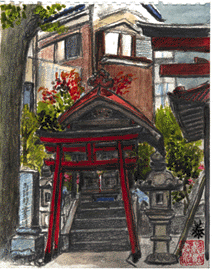The text is from here.
Hazawa Inari
Last updated on September 10, 2024.
Please note that the content introduced here may differ from the current one.
32.Hazawa Inari (1-103, Nishitobe-cho)

Inari is the turn of Inao, and is said to have worshiped the Kura Inatamagami, who controls the five grains.
However, Fushimiinari in Kyoto is a Shinto system, while Toyokawainari is a Buddhist system called Soto sect En Fukuyama Myogonji. And this is the main deity. In other words, it can be said that it is a synonymous with Shinto and Buddha (*).
The Inari religion spread not only to food, but also to countless people throughout the country because of its wide range of defense, including domestic security and thriving business.
By the way, Hazawa Inari was forced to relocate several times to this day, but since Taisho 6 (1917), it has been enshrined at its current location. Even though it is small, there is a Kagura Hall, and the fox of the goddess is also lovely.
※A religion that links Shinto and Buddhism. It's also called syncretism of Shinto and Buddhism.
Bun, picture Tai Hasegawa (presidency of the Nishi Ward Cultural Association Kitora Association)
Inquiries to this page
Nishi Ward General Affairs Department Ward Administration Promotion Division Public Relations Section
Phone: 045-320-8321
Phone: 045-320-8321
Fax: 045-314-8894
E-Mail address [email protected]
Page ID: 755-272-835













